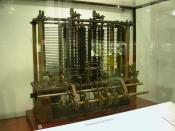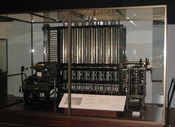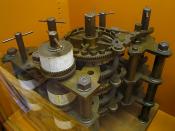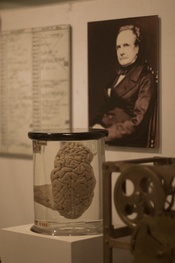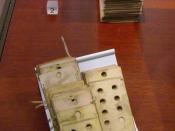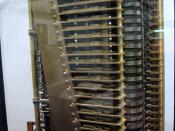Charles Babbage was born in Devonshire, England, in 1791. Babbage's father, Benjamin Babbage, was a banker.
Babbage was a pale and sickly child who was exceptionally good in math and was "a profound thinker."ÃÂ He went to Trinity College and received his master degree in 1817.
In 1812 Charles wanted to build a mechanical calculating machine. His idea was a machine that calculated, printed out the data, and solved equations. This idea would come in handy to the sailors of that time period since many ships were destroyed or lost because of errors in navigational tables, he suggested that his machine (which would be known as the Difference machine) would make error-free tables for the sailors. By June 1823, the Royal Society (British Government) had granted his request for money; he received 1,500 pounds.
When Charles Babbage started his invention, he seriously underestimated his idea. The complexity of the machine was too far fetched.
Babbage soon became a toolmaker since the tools he needed did not exist. He struggled with the machine for ten years, until he eventually gave up the idea. His Difference Engine was soon known as "Babbage's Folly"ÃÂ Did Babbage stop inventing? Not at all. He quickly began a new idea of an Analytical Engine. This idea however had a simple design. This invention would calculate and make a table of the six decimal places.
This new idea of his had two main parts to it: "the store"ÃÂ and "the mill"ÃÂ.
"The store"ÃÂ was a term he used to describe the engine's memory. Here's how he described it: "The store is in which all the variables to be operated upon, as well as those quantities which have arisen from the result of other operations, are placed."ÃÂ The second term "The mill"ÃÂ is basically (as we would know it) the central processing unit. Here's how he described it: "The mill into which the quantities about to be operated upon are always brought."ÃÂ Charles also took the idea from Jacquard using punch card to "direct the nature of the operations to be performed."ÃÂ The Analytical Engine creation process was slowed due to Babbage working on his other inventions, such as a device used to measure the vibration of buildings caused by traffic. He also wrote a novel based on his studies of mechanical devices and machinery in manufacturing. This book was called Economy Of Manufactures and Machinery.
In 1820 Charles Babbage met Lord Byron, the poet, and his daughter, Ada Augusta King, also known as Lady Lovelace.
Lady Lovelace was a mathematician herself. She understood Babbage's ideas and was impressed by them. Lovelace soon became involved with Babbage's work and introduced him to many important people.
Besides being a mathematician, Lady Lovelace was also a gifted writer like her father. This came in handy when she translated a French technical paper from the engine. She also extended some of Charles' ideas with her own and corrected his work. (She often signed his notes that were done by her with A.A.L., her initials.) One of her major accomplishments towards the Analytical Machine was the "notion of repeating one set of instructions over and over when making a calculation."ÃÂ Today these are known as subroutines. Because of Lady Lovelace's work, she is considered to be the world's first computer programmer.
Through the years Charles Babbage had lost the grant money for his inventions. For about eleven years Babbage was trying to raise money for his engine. He wrote a few children's books, but they were mainly for fun than to raise money.
Babbage kept busy with a high social schedule and scientific activities, but didn't raise the money to finish the machine. He died at age 80 in London thinking himself as a failure.
As for Lady Lovelace, she also kept very busy. She met Andrew Crosse, an inventor who dedicated his life to electricity and magnetism. Lovelace met and liked John Crosse (Andrew Crosse's son). He was a high gambler on horses; this caused Lady Lovelace to start to gamble and she was soon badly in debt.
In 1850 Lady Lovelace found out she had cancer. Her family supported her and helped get her out of debt. She died at the age of 36. (Same age as her father when he died.) Babbage's young son, Henry Prevost Babbage tried to continue the construct of the Analytical Engine, but he didn't get too far. Eventually what Babbage had completed (he only completed the mill) and his notes and drawings were placed in the Science Museum in London.
About ten years later Henry tried to make a simple design of the mill. This mill was able to compute a table of the first 32 multiples of pie, but then it failed. Also, Henry's design kept sticking, and no one was able to fix it. He soon gave up on the idea and donated it to the Science Museum.
Henry Babbage took a lot of his father's work and made it into a book. This book was called, Babbage's Calculating Engines. This book may be the best source of information about Babbage's work.
Bibliography 1. Computers: From Babbage the Fifth Generation By: Ron Schneiderman 2. Academic American Encyclopedia 3. Encyclopedia Americana 4.Http://ei.cs.vt.edu/~history/Babbage.html 5. Http://www.nmsi.ac.uk/on-line/treasure/objects/1862-89.html
